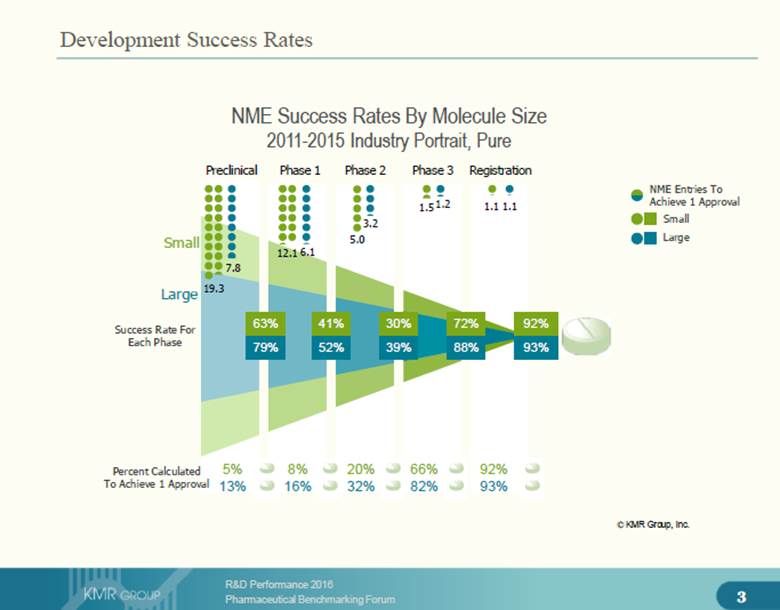Large vs. Small Molecule Success Rates
CHICAGO, Illinois – A recent assessment of R&D success rates reveals that large molecules continue to outperform small molecules, particularly in the early phases of Development. Overall, from start of GLP Tox to Approval, small molecules have a 5% chance of success compared to 13% for large. In Preclinical small molecules have a 63% rate of success vs. 79% for large molecules; the difference in Phase I is 41% for small molecules vs. 52% for large. The only phases where there is a statistically significant variance (p < .05) in molecule size is in Preclinical and Phase I, but large molecules tend to have higher rates in all phases. In recent years, Phase I has been relatively stable for both small and large molecules, while Phase II has shown significant improvement for small molecules while large molecules have had their rates decline. In Late Development (Phase III and Registration) both small and large molecules have improved success rates. This is based on data released by the Pharmaceutical Benchmarking Forum, a group of large biopharma which integrates R&D productivity data and analyzes performance and trends.

Notes: “Small” refers to chemical molecules; “Large” refers to biologics (including peptides); vaccines are excluded; “Industry Portrait” means all data from contributing companies is combined into single analysis (as if they were a single company) Pure method employed: for given molecule size, all in-licensed/acquired NMEs excluded from calculation for the phase in which they entered, but included for all subsequent phases Method to calculate Success Rate: (number of small molecule successes in phase) / ((number of small molecule terminations in phase) + (number of small molecule successes in phase)); same method applied for large molecules Percent calculated to achieve 1 Approval for small molecules: apply multiplier method for each phase for small molecules (e.g., Phase 2 rate starts with Industry Phase 2 success rate and multiplies all subsequent phase success rates); same method applied for large molecules The PBF was organized in 1997. In 2016 the following submitted R&D data: AbbVie, Allergan, Bayer, Boehringer Ingelheim, Bristol-Myers Squibb, Eli Lilly, Johnson & Johnson, Merck Research Labs, Novartis, Pfizer, Roche, Sanofi, Takeda. About the Pharmaceutical Benchmarking Forum (PBF) Formed in 1997, the Pharmaceutical Benchmarking Forum (PBF) consists of many of the world’s leading pharmaceutical companies and has emerged as the Industry’s premier source on R&D performance metrics. Its focus is to employ careful analysis of R&D data to compare performance, examine Industry trends, answer critical business questions, and identify best practices. The scope of the Forum extends across the full R&D spectrum, from a detailed examination of Discovery to an annual review of R&D performance, including productivity, success rates, cycle time, and pipeline. In addition to its flagship study on R&D performance, the PBF sponsors additional studies on topics of interest to the Industry. These specialist studies range from the evaluation of project cost to an in-depth look at biologics R&D. About KMR Group KMR has been working exclusively in the biopharmaceutical R&D industry since the early 1990s. KMR is a leader in benchmarking, analytics and performance management as well as a developer of proprietary analytics software. With an exclusive focus on biopharmaceutical R&D and unrivaled commitment to data quality, KMR provides industry with the experience and knowledge to produce clear and uncompromising results in the form of reports, tools and presentations. We use our extensive, unparalleled datasets and experience within the industry to add value to the most pressing business questions. Please visit our website at https://kmrgroup.com
Improving Relationships and Diversifying the Site Selection Process
April 17th 2025In this episode of the Applied Clinical Trials Podcast, Liz Beatty, co-founder and chief strategy officer, Inato, discusses a number of topics around site engagement including community-based sites, the role of technology in improving site/sponsor relationships, how increased operational costs are impacting the industry, and more.
Behind the Buzz: Why Clinical Research Leaders Flock to SCOPE Summit
February 7th 2025In this episode, we meet with Micah Lieberman, Executive Conference Director for SCOPE Summit (Summit for Clinical Ops Executives) at Cambridge Innovation Institute. We will dive deep into the critical role of collaboration within the clinical research ecosystem. How do we bring together diverse stakeholders—sponsors, CROs, clinical trial tech innovators, suppliers, patients, sites, advocacy organizations, investors, and non-profits—to share best practices in trial design, program planning, innovation, and clinical operations? We’ll explore why it’s vital for thought leaders to step beyond their own organizations and learn from others, exchanging ideas that drive advancements in clinical research. Additionally, we’ll discuss the pivotal role of scientific conferences like SCOPE Summit in fostering these essential connections and collaborations, helping shape the future of clinical trials. Join us as we uncover how collective wisdom and cross-industry partnerships are transforming the landscape of clinical research.